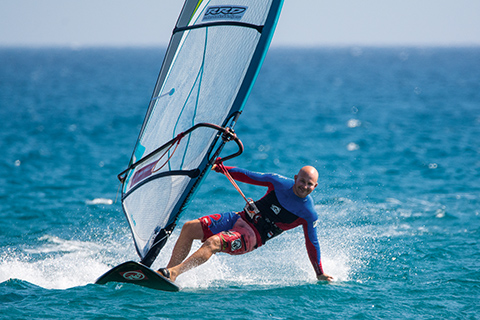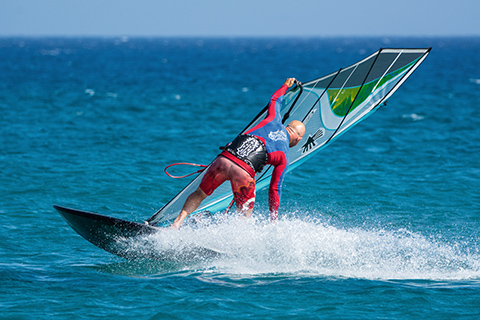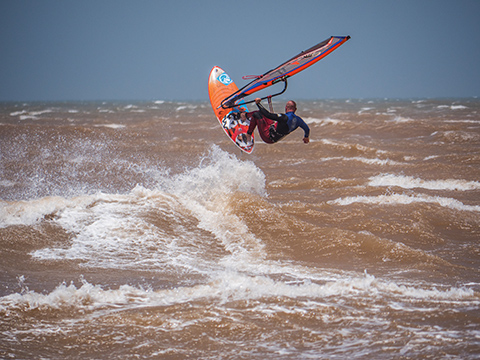JEM HALL
MOVE ON UP – WINDSURFING TECHNIQUE
LETTING GO
It is that time of year where we often refresh our view and perhaps think, out with the old and in with the new. So this feature is all about trying something new, or improving in this area, and implores you to ‘Let Go!’. As a wise man once said, “Love is Letting Go of Fear” (Jerry Jampolsky); so if you indeed love your windsurfing, then now is the time to ‘Let Go!’.
I have been using the skill and drill of taking one hand off the boom for over 20 years of coaching and all the way from Beginner to Winner. It works for Beginners in helping them discover the power point of the sail and for Winners to smoothen up their top turn and refresh their wave riding.
Letting go of the boom, with one or both hands, has the benefits that it makes us get low; position the rig correctly; get away from the rig; examine our sheeting angle on the sail and position our hands more effectively on the boom. I also counter that it helps us to take a more risk taking mindset which is crucial to moving forward in our sailing. When one of my rippers does not let go of the boom, it tells a lot about not only their skills, but also their mindset!
Words Jem Hall // Photo Nicolas Jones, Dimitris Vergos & Clive Boden
www.jemhall.com
(This feature originally appeared in the January/February 2016 issue of Windsurf Magazine. To read more features like this first, Print and Digital subscriptions are available. Prices include delivery globally for 10 x issues a year!)
BRILLIANT BASICS
Taking a hand off the boom, if only quickly, can be done in your first few hours of windsurfing. So if you are teaching a friend or are new to our great sport, then get your hands close together in order to feel where the sail has a balanced pull and then, in light winds, take one hand off. Hoorah, welcome to counter balancing in windsurfing, a lifelong required sailing skill!
When I am coaching first time harness use I get people to let go of their front hand so they are forced to control the sail’s power with their hips, steer with their feet, and trim the sail correctly. I often find that the earlier you do this in your harness user journey then the faster your stance improves!
Letting go of one hand or the other, in a comfortable stance either planing or non-planing and hooked in, has different benefits.
Front hand off:
- Makes you move outboards and get low.
- Drops your front shoulder.
- Gets you looking more in the direction of travel.
- Helps you get better upwind stance.
- Builds future front hand off skills (see later in feature).
- Ensures you trim the sail right, often sheeting out slightly.
Backhand off:
- Really helps you to lean outboard and learn to power the sail up using your hips and body.
- Ensures you pull down more on your front arm.
- Makes you even more aware of sail trim.
It is important to note that either hand off makes you more aware of using your legs more to control power and steer. Letting go of the boom also looks more dynamic in pics and revs up your POV camera shots.
// Letting go and dragging that front hand gets you lower and more dynamic’ PHOTO Nicolas Jones
COMPLIMENT YOUR CARVES
Now you have boosted your stance with heaps of hands off blasting, it is time to add some zap and dynamism to your carving moves. There are two simple moves do this:
- Front hand off carve gybes.
- Attempting a carving 360 in the straps, which is further boosted by dropping your front hand.
// Dropping the back hand gets me sheeting in more and pulling down on the front arm. PHOTO Nicolas Jones
One handed gybes
For the one handed carve gybe, after your prep phase (check my previous features), slide your back hand up the boom to the back harness line. Next, take your front hand off the boom and go with the rig as you roll into your carve. This action will help you bend your ankles, commit to your carve and drop the sail to the inside of your turn. Be warned, this will make everything very responsive and it will transform your gybes; and of course, help you let go. To finish off, place your front hand back on the boom and then bring the sail back up, open it and carve out as per usual.
// Dropping the front hand in carving moves helps you show the sail to the water and commit to your carves’ PHOTO Nicolas Jones
Free your Carving 360
Looking to learn carving 360’s one handed will get you approaching your carves faster and really leaning into your carves. It also gives you a more laissez faire attitude as you know you are working on a new move and just going for it. This move has worked wonders for people on my coaching holidays, is a lot of fun and looks fab in pics too. Again, bringing your back hand up the boom and dropping your front hand means the sail really falls to the inside, taking you with it and this results in the rig going to a more natural position, where your front hand can no longer ‘handbrake’ the rig. Go on, do it. The carve 360 is covered on my archive of technique articles on this magazine’s fab website.
// Reaching for the water in your duck gybe ensures your hand is back and that you bend ze knees. PHOTO Nicolas Jones
Release the Duck
The last carving move I will suggest here is to give it a bit of old school and look to do a hand drag duck gybe. This has really helped me have more fun and get low in my ducks, even if we can all only aspire to get some Goya/Naish/Baker style into it. To do the move you have to get your old front hand, the crossing over hand, right to the back of the boom so you can then pull the sail across you as get low, look at your exit and then get that other hand in the water. Do not worry too much about finishing the duck gybe, your target is hand in or near the water and then build on being comfy here and then in time you can be finishing this move off in style!
ADVANCING ACTIONS
We are now reaching into the heady heights of more radical conditions and the realms of wavesailing. There are some great boosts you can bring into your jumps and waveriding.
Joyous jumps
For the jumping you are looking to build upon your existing skills of comfy hand/s off blasting and airtime competency, yet now you will be dropping either your fronthand or backhand in the air. Again letting go of either hand has different relative benefits.
// Letting that front hand go in your jumps ensures you get outboard and sheet out with the back hand. PHOTO Clive Boden
Fronthand off:
- Ensures you get outboard and sheet out with the backhand, to avoid the dreaded nose drop!
- Makes you scissor (steer) the board off the wind in the air so makes your legs more active.
- Might Inspire you to grab the mid rail with the ensuing benefit of pointing your toes in the air.
// Letting go and tail grabbing ensures you lift your tail and get your body outboards. PHOTO Dimitris Vergos
Backhand off:
- Ensures you again get your body outboards.
- Makes you have to pull in on front arm, which lifts the nose of the board for better flight time.
- Inspires you to lift your tail as you look to grab it.
Both of these jumps will put you in that risk taking, go for it mindset which is all so necessary should you want to move forward as an advanced rider.
Topping your top turn
Performing this next action is a game changer in not only adding some style to your waveriding but also in vastly improving the precision in your hand movements. The basic mechanics of wave riding frontside is hands apart in the bottom turn (going downwind) and hands together in the top turn (steering back upwind). We can all boost this skill and so if we look to drop our front hand in the top turn, then it is the ultimate hand sliding movement improver, as it will make you:
- Get away from the rig and get low, as you look to counter balance the rig’s position.
- Position the rig forwards, so you don’t get pulled over, or out the back of the wave.
- Sheet the sail out, or open it, as you look to spill wind and gain control.
- Exaggerate your hand movements both up and down the boom. Surf the boom and the wave!
// Dropping your front hand in a waveriding top turn makes you get out, low and move your back hand up the boom. PHOTO Clive Boden
KIT
Generous straps allow your feet access, in order to bear the board away on the water and in the air, get your toes down and carve hard.
Long lines enable you to get away from the kit. Vital when one handed!
Place your harness lines where there is an even pull on both hands.
Relatively flatter sail gives you more control and feel.
RRD boards, wetsuits, softwear, Ezzy sails and Pro Sport Sunblock sponsor Jem Hall. Get him live and direct on one of his highly acclaimed coaching holidays. You can also follow him on twitter / Facebook and Instagram.
www.jemhall.com









